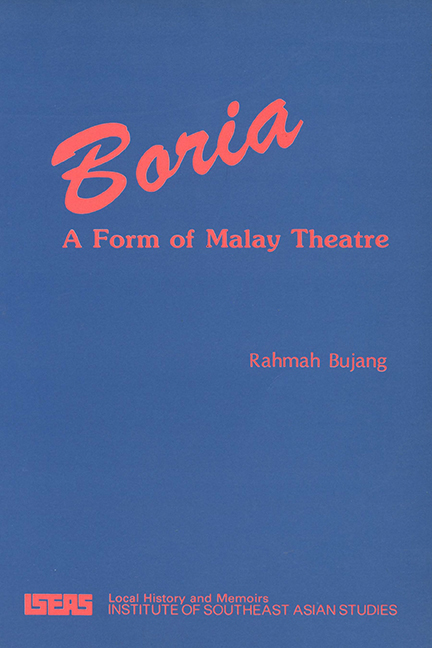1 - Sources on Boria
Published online by Cambridge University Press: 21 October 2015
Summary
Sources
The sources on boria are fairly limited, consisting of short articles, passing comments in wider studies of theatre, and scattered notes. Boria was first mentioned by H.T. Haughton (1897, pp. 312-13). According to him it was first brought to Penang in 1845 by the 21st Regiment of Madras which had been transferred there to garrison the fort. A song and dance form, it was played by the Indian Muslims of the regiment for ten days in the month of Muharram when they had holiday leave to celebrate the annual Shi'ite festival of mourning for Hussein, a grandson of the Prophet Muhammed. Under the designation of the Muharram festival therefore, sources on boria date back to 1845 according to Haughton. In 1558 J.D. Vaughan (1970, pp. 116-75) mentioned it as an activity of the Jawi-Pekan of Penang. Another significant early source is the Penang Riot Commission Report of 1868 (hereafter referred to as the 1867 Riot Report). In this repct investigation into the cause and effects of the Penang riots 1867 revealed that two rival Malay associations, the Red Fia and White Flag societies, formed a few years earlier to perform in the Muharram festival were allied to Chinese secret societies and were involved with them in the riots. The committee's proposals in the report led to the future confinement of activities to religious festivities in their own village areas. Though there is no information in the report on boria as a drama form, it does provide us with a contemporary source on the locations and political activities of some of its actors and performers.
R.J. Wilkinson (1910), a Straits Civil Service Officer and noted Malay scholar, discussed boria as a form of Malay amusement. He compared the boria of Madras to that of Penang and established that the resemblance was only in name, for the show as then known in Penang had a totally different form.
- Type
- Chapter
- Information
- BoriaA Form of Malay Theatre, pp. 1 - 5Publisher: ISEAS–Yusof Ishak InstitutePrint publication year: 1987



